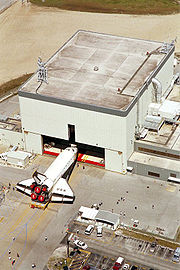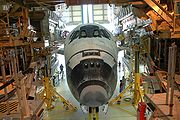
Orbiter Processing Facility
Encyclopedia

Hangar
A hangar is a closed structure to hold aircraft or spacecraft in protective storage. Most hangars are built of metal, but other materials such as wood and concrete are also sometimes used...
s where U.S. space shuttle orbiter
Space Shuttle Orbiter
The Space Shuttle orbiter was the orbital spacecraft of the Space Shuttle program operated by NASA, the space agency of the United States. The orbiter was a reusable winged "space-plane", a mixture of rockets, spacecraft, and aircraft...
s underwent maintenance between flights. All three such facilities, OPF-1, OPF-2 and OPF-3, were located at NASA
NASA
The National Aeronautics and Space Administration is the agency of the United States government that is responsible for the nation's civilian space program and for aeronautics and aerospace research...
's Kennedy Space Center
Kennedy Space Center
The John F. Kennedy Space Center is the NASA installation that has been the launch site for every United States human space flight since 1968. Although such flights are currently on hiatus, KSC continues to manage and operate unmanned rocket launch facilities for America's civilian space program...
in Florida
Florida
Florida is a state in the southeastern United States, located on the nation's Atlantic and Gulf coasts. It is bordered to the west by the Gulf of Mexico, to the north by Alabama and Georgia and to the east by the Atlantic Ocean. With a population of 18,801,310 as measured by the 2010 census, it...
at Launch Complex 39.
They were located west of the Vehicle Assembly Building
Vehicle Assembly Building
The Vehicle Assembly Building, or VAB, at NASA's Kennedy Space Center was used to assemble and house American manned launch vehicles from 1968-2011. It is the fourth largest building in the world by volume...
, where the orbiter was mated with its External Tank and Solid Rocket Booster
Space Shuttle Solid Rocket Booster
The Space Shuttle Solid Rocket Boosters were the pair of large solid rockets used by the United States' NASA Space Shuttle during the first two minutes of powered flight. Together they provided about 83% of liftoff thrust for the Space Shuttle. They were located on either side of the rusty or...
s before transport to the launch pad. OPF-1 and OPF-2 are connected with a low bay between them, while OPF-3 is across the street.
OPF-3 was previously called the Orbiter Maintenance & Refurbishment Facility (OMRF), but was upgraded to a fully functioning OPF.
Processing flow

- The orbiter's main enginesSpace Shuttle main engineThe RS-25, otherwise known as the Space Shuttle Main Engine , is a reusable liquid-fuel rocket engine built by Pratt & Whitney Rocketdyne for the Space Shuttle, running on liquid hydrogen and oxygen. Each Space Shuttle was propelled by three SSMEs mated to one powerhead...
were purged to remove the moisture that was a by-product of liquid oxygen and liquid hydrogen combustion. - payload bay doors were opened and any hazardous payloads were processed for safety
- fuel cells tanks were drained of remaining cryogenic reactants. The oxygen system was rendered inert with gaseous nitrogen and the hydrogen system with gaseous helium.
- high pressure gases were vented from the environmental control and life support systems.
- refuse and other waste products including draining of the potable water system were offloaded
- heat shields were removed from the engines and aft access were opened
- main engines were locked in place and covers installed.
- scaffolding was installed around the orbiters aft to allow technicians to access the main engines
- main engines were removed and transferred to the Main Engine Processing Facility for checkout and service
- any needed repairs on the orbiter's thermal protection system including the thermal blankets and thousands of tiles were completed.
- the Orbital Maneuvering System and Reaction Control SystemReaction control systemA reaction control system is a subsystem of a spacecraft whose purpose is attitude control and steering by the use of thrusters. An RCS system is capable of providing small amounts of thrust in any desired direction or combination of directions. An RCS is also capable of providing torque to allow...
pods were possibly removed and transferred to the Hypergol Maintenance FacilityHypergol Maintenance FacilityHypergol Maintenance Facility is a rocket fuel and engine center located in an isolated location in the Kennedy Space Center industrial area. It was constructed in 1964 to support the Apollo program and upgraded in 1985 to support the Space Shuttle program...
for troubleshooting, repair or other services. - any modifications to the orbiter were completed in the OPF.
- After all its flights, the orbiter went through "Down Mission Processing."
Prior to rollout to the Vehicle Assembly Building
Vehicle Assembly Building
The Vehicle Assembly Building, or VAB, at NASA's Kennedy Space Center was used to assemble and house American manned launch vehicles from 1968-2011. It is the fourth largest building in the world by volume...
, several weeks before scheduled launch, the orbiter was prepared for the next mission by installing mission flight kits, payloads, consumable fluids and gases where possible. Remaining payloads, fuels and fluids were installed on the pad closer to launch day. The last step before rollover to the VAB was weighing the orbiter to determine its center of gravity.

